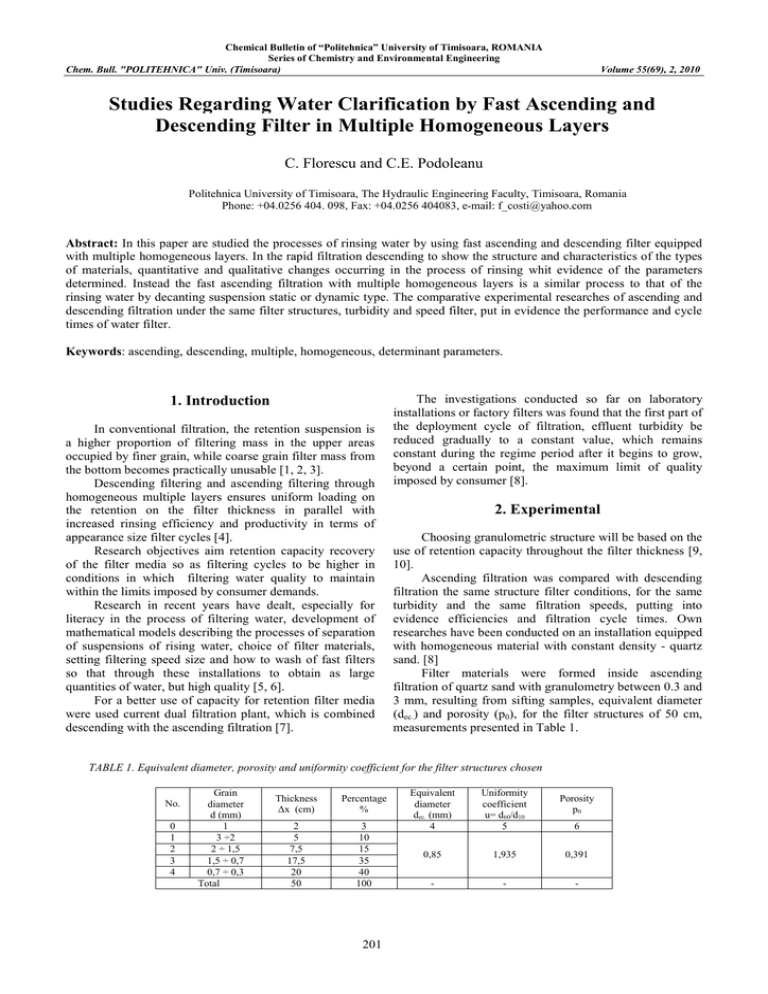Document 13359729
advertisement

Chemical Bulletin of “Politehnica” University of Timisoara, ROMANIA Series of Chemistry and Environmental Engineering Chem. Bull. "POLITEHNICA" Univ. (Timisoara) Volume 55(69), 2, 2010 Studies Regarding Water Clarification by Fast Ascending and Descending Filter in Multiple Homogeneous Layers C. Florescu and C.E. Podoleanu Politehnica University of Timisoara, The Hydraulic Engineering Faculty, Timisoara, Romania Phone: +04.0256 404. 098, Fax: +04.0256 404083, e-mail: f_costi@yahoo.com Abstract: In this paper are studied the processes of rinsing water by using fast ascending and descending filter equipped with multiple homogeneous layers. In the rapid filtration descending to show the structure and characteristics of the types of materials, quantitative and qualitative changes occurring in the process of rinsing whit evidence of the parameters determined. Instead the fast ascending filtration with multiple homogeneous layers is a similar process to that of the rinsing water by decanting suspension static or dynamic type. The comparative experimental researches of ascending and descending filtration under the same filter structures, turbidity and speed filter, put in evidence the performance and cycle times of water filter. Keywords: ascending, descending, multiple, homogeneous, determinant parameters. 1. Introduction In conventional filtration, the retention suspension is a higher proportion of filtering mass in the upper areas occupied by finer grain, while coarse grain filter mass from the bottom becomes practically unusable [1, 2, 3]. Descending filtering and ascending filtering through homogeneous multiple layers ensures uniform loading on the retention on the filter thickness in parallel with increased rinsing efficiency and productivity in terms of appearance size filter cycles [4]. Research objectives aim retention capacity recovery of the filter media so as filtering cycles to be higher in conditions in which filtering water quality to maintain within the limits imposed by consumer demands. Research in recent years have dealt, especially for literacy in the process of filtering water, development of mathematical models describing the processes of separation of suspensions of rising water, choice of filter materials, setting filtering speed size and how to wash of fast filters so that through these installations to obtain as large quantities of water, but high quality [5, 6]. For a better use of capacity for retention filter media were used current dual filtration plant, which is combined descending with the ascending filtration [7]. The investigations conducted so far on laboratory installations or factory filters was found that the first part of the deployment cycle of filtration, effluent turbidity be reduced gradually to a constant value, which remains constant during the regime period after it begins to grow, beyond a certain point, the maximum limit of quality imposed by consumer [8]. 2. Experimental Choosing granulometric structure will be based on the use of retention capacity throughout the filter thickness [9, 10]. Ascending filtration was compared with descending filtration the same structure filter conditions, for the same turbidity and the same filtration speeds, putting into evidence efficiencies and filtration cycle times. Own researches have been conducted on an installation equipped with homogeneous material with constant density - quartz sand. [8] Filter materials were formed inside ascending filtration of quartz sand with granulometry between 0.3 and 3 mm, resulting from sifting samples, equivalent diameter (dec.) and porosity (p0), for the filter structures of 50 cm, measurements presented in Table 1. TABLE 1. Equivalent diameter, porosity and uniformity coefficient for the filter structures chosen No. 0 1 2 3 4 Grain diameter d (mm) 1 3 ÷2 2 ÷ 1,5 1,5 ÷ 0,7 0,7 ÷ 0,3 Total Thickness ∆x (cm) Percentage % 2 5 7,5 17,5 20 50 3 10 15 35 40 100 201 Equivalent diameter dec. (mm) 4 Uniformity coefficient u= d60/d10 5 0,85 1,935 0,391 - - - Porosity p0 6 Chem. Bull. "POLITEHNICA" Univ. (Timisoara) Volume 55(69), 2, 2010 3. Results and Discussion 3.1. Descending Filtration in Homogeneous Layers (Quartz Sand) Jumps shown in experimental research for descending filtration, are determined by deposits peeling on layers from the upper horizons, due to increase interstitial speeds leading to amplification of transport phenomena. For descending filtration (dx = 50 cm), with turbidity of 52 ÷ 57 NTU, was intended to determine a mathematical equation that describes at any time, the resistance coefficient λ in relation to the specific deposit σ for the three speeds considered 5, 10 and 15 m / h. From the graphical representation of experimental results for descending filtration v = 5 m / s and ∆x = 50 cm, (figure 1), it can be observe the curve that describes a mathematical equation of the form: λ = 1,613 + 0,0178·σ – 0,0003·σ2 (1) Differences in actual and theoretical measurements of the parameter λ can be seen in Table 3. TABLE 2. The resistance coefficient λ in relation to the specific deposit σ for the three speeds when descending filtration dech. (mm) 1 0.85 0.85 v (m/h) 2 5 10 λ (m-1) ∆σ (g/dm3) 3 15 λ0 (m-1) 100 200 300 400 500 600 900 1100 4 5 6 7 8 9 10 11 λ 1.65 1.75 1.82 1.85 1.90 1.90 1.85 1.80 Σ ∆σ 3.3 7.5 12.4 17.3 25 27 42.3 57.3 λ 1.27 1.35 1.50 1.52 1.52 1.45 1.0 0.70 Σ ∆σ 7.2 15.2 21.7 32.8 41 49.3 81.5 104.9 1.05 1.18 1.05 0.85 0.75 - - - 16 32 50 65 78 - - - 12 1.60 λ 0.85 ∆x = 50 cm TIME (min.) Σ ∆σ λ (1/m) 1.20 0.75 y = -0.0003 x 2 + 0.0178x + 1.613 R 2 = 0.9678 2 1.8 1.6 1.4 Theoretical curve 1.2 Descending filtration v = 5 m/h ∆x = 50 cm 1 0.8 0.6 Experimental curve 0.4 0.2 σ (g/dm3) 0 0 20 40 60 80 100 120 Figure 1. Determining the mathematical equation for λ=f(σ) for descending filtration with v= 5 m/s and ∆x=50 cm TABLE 3. Actual and theoretical values of the coefficient of resistance λ for descending filtration No. 0 1 2 3 4 5 6 7 8 9 Values of λ depending on σ, if the descending filtration v = 5 m/s and ∆x = 50 cm Actual values Theoretical values 1 2 1,60 1,613 1,65 1,668 1,75 1,729 1,82 1,787 1,85 1,831 1,9 1,870 1,9 1,875 1,85 1,829 1,8 1,648 202 Differences Percentage % 3 0,013 0,018 0,02 0,032 0,018 0,029 0,024 0,040 0,151 4 0,8 1 1,1 1,7 0,9 1,5 1,2 2,1 8,3 Chem. Bull. "POLITEHNICA" Univ. (Timisoara) Volume 55(69), 2, 2010 3.2. Ascending Filtration in Homogeneous Layers (Quartz Sand) Jumps shown in experimental research for ascending filtration are determined by deposits peeling on layers from the lower horizons, due to increased interstitial speeds leading to amplification of transport phenomena. For ascending filtration (∆x = 50 cm), with turbidity of 54 ÷ 58 NTU, was intended to determine a mathematical equation that describes at any time, the resistance coefficient λ in relation to the specific deposit σ for the three speeds considered 5, 10 and 15 m / h (table 4). From the graphical representation of experimental results for ascending filtration with v = 5 m /s and ∆x = 50 cm (figure 2), it can be observethar the curve describes a mathematical equation of the form: λ = 1,7523 + 0,0252·σ – 0,0003·σ2 (2) Differences between actual and theoretical measurements of the parameter λ can be seen in Table 5. TABLE 4. The resistance coefficient λ in relation to the specific deposit σ for the three speed when ascending filtration dech. (mm) 1 0.85 0.85 v (m/h) 2 5 10 λ (m-1) ∆σ (g/dm3) 3 15 λ0 (m-1) 100 200 300 400 500 600 900 1100 4 5 6 7 8 9 10 11 12 λ 1.85 1.95 2.10 2.15 2.2 2.2 2.12 2.0 1.75 Σ ∆σ 4.5 10 15.4 23 27.5 33.1 50.6 63 - λ 1.5 1.65 1.70 1.75 1.70 1.60 1.2 0.65 1.25 Σ ∆σ 10.5 16 26.6 38.1 47.6 58.2 88.7 106.5 - 1.1 1.2 1.1 0.8 0.65 - - 0.75 17.1 35.8 54.9 70.8 84 - - - λ 0.85 ∆x = 50 cm TIME (min.) Σ ∆σ 2 y = -0.0003 x + 0.0252x + 1.7523 R2 = 0.9814 λ(1/m) 2.5 2 1.5 Ascending filtration v = 5 m/h ∆x = 50 cm 1 Theoretical curve Experimental curve 0.5 0 σ(g/dm3) 0 20 40 60 80 100 120 140 Figure 2. Determining the mathematical equation for λ = f (σ) for ascending filtration with v = 5m / s and ∆x = 50 cm TABEL 5. Actual and theoretical values of the coefficient of resistance λ in the case of ascending filtration No. 0 1 2 3 4 5 6 7 8 9 Values of λ depending on σ, for the ascending filtration v = 5m/s and ∆x = 50 cm Actual values Theoretical values 1 2 1,75 1,752 1,85 1,859 1,95 1,97 2,1 2,07 2,15 2,17 2,2 2,21 2,2 2,25 2,12 2,26 2 2,14 203 Differences Percentage % 3 0,002 0,009 0,024 0,03 0,023 0,018 0,057 0,13 0,15 4 0,1 0,4 1,0 1,4 0,9 0,4 2,2 6,2 6,5 Chem. Bull. "POLITEHNICA" Univ. (Timisoara) Volume 55(69), 2, 2010 Comparing the results between ascending and descending filtering result that the specific charges and retained masses are for 10 to 15% higher in ascending towards descending filtration [8]. This aspect is the result of more uniform loading of the filter layers. Specific deposits have important values at low filter speeds, values that are reduced as it increases the speed of filtration. After processing the experimental data have revealed, by comparison, parameter values λ0, λmax, a, b, c of the ascending filtration to the descending filtration, with the same granular structure, Table 6 and 7. TABEL 6. Parameter values λ0, λmax., a, b, si c to ascending filtration No. 0 1 2 3 λ0 1 1,7523 1,3046 0,78 λmax. 2 2,28 1,66 1,15 σ1 3 42 34,8 35,1 σs=σmax. 4 129,2 109,41 97,1 a 5 1,7523 1,3046 0,78 b 6 0,0252 0,0209 0,0211 REFERENCES c 7 0,0003 0,0003 0,0003 TABEL 7. Parameter values λ0, λmax., a, b, si c to descending filtration No. 0 1 2 3 λ0 1 1,613 1,212 0,78 λmax. 2 1,87 1,46 1,07 σ1 3 29,6 30,5 31,5 σs=σmax. 4 108,76 100,21 91,49 a 5 1,613 1,212 0,78 b 6 0,0178 0,0142 0,0189 Ascending filtration, presents a number of shortcomings related to filtering speed limit. These filtration speeds should not exceed 10 ÷ 12 m/h. It also recommends that at the ascending filtration, wash water collecting gutters to be covered with wire nets so that washing water to train the filter material [11]. Determining the optimal wash speed to reduce losses of filter material and setting maximum filter speeds to eliminate the phenomenon of flow [8]. Studying whether the use of ascending filtration in the process of nitrification-denitrification in treatment technologies [1]. c 7 0,0003 0,0002 0,0003 From the analysis resulted that saturation specific deposit for ascending filtering is to 15.8% higher than the descending filtering for the speed of 5 m /h and is reduced to 5.7 % for speed of 15 m /h. Mathematical models used to describe the phenomena of separation from descending filtering were found to the ascending filtering, too, similarities highlighted by parameters characteristic sizes. In comparison of the ascending and descending filtration, for the same speed and same turbidity, result that the filtration cycle time for the fast ascending filtering is almost twice higher than for fast descending filtering. 1. Giurconiu M., Mirel I., Carabet A., Chivereanu D., Florescu C. and Staniloiu C., Construction and hydro plants. Western Publishing, Timisoara, 2002. 2. Manescu A., Water supply - application. Ed. H.G.A., Bucharest, 1998. 3. Manescu A., Sandu M. and Ianculescu O., Water supply. Didactic and Pedagogical Publishing House, Bucharest, 1994. 4. Mirel I., Contributions to the study of rapid filtration processes in the initial period of detention. PhD thesis, Timisoara, 1974. 5. Mirel I. and Florescu C., Fast multilayer filters. Conference with international participation. Edition 12. Plant construction and environmental comfort, Timisoara, 10-11 April 2003. 6. Mirel I., Pode V., Florescu C. and Podoleanu C., Rev. Chim. (Bucharest), 56(2), 2005. 7. Mirel I., Florescu C., Staniloiu C., Segneanu E. and Savescu E., Issues Concerning for sand filtration for advanced water waste treatment. Preventing and fighting hydrological disartes. The international Conference, Timisoara, 21-22 Nov. 2002. 8. Florescu C., Contributions to the study of rinsing processes using rapid multilayer filters. PhD thesis Timisoara in October. 2005. 9. Pislarasu I., Rotaru N. and Teodorescu M., Water supply, Bucharest, Technical Publishing, 1981. 10. Trofin P., Water supply. Didactic and Pedagogical Publishing House, Bucharest, 1983. 11. Florescu C., Podoleanu C. and Batea F., Optimization of the exploitation of fast multiple layers filtration installations. Innovations in the field of water supply, sanitation and water. Conference for Young Professionals Bucharest, 15-17 June, 2005. 12. Rusu G. and Rojanschi V., Filtration in treatment technique and water treatment. Technical Publishing, Bucharest, 1980. 4. Conclusions Experimental research revealed for the same type of material, ascending filtration improvement to descending filtration, part due to sorting mode in relation to grain size and direction of water flow [8]. Received: 08 April 2010 Accepted: 15 December 2010 204





